1. Line Segments, Angles and Triangles
- Books Name
- CBSE Class 6 Mathematics Book
- Publication
- Param Publication
- Course
- CBSE Class 6
- Subject
- Mathmatics
Introduction
All the shapes we see around us are formed using curves or lines. We can see corners, edges, planes, open curves and closed curves in our surroundings. We organise them into line segments, angles, triangles, polygons and circles. In this chapter we have to compare and measure their sizes.
1. Line Segments, Angles and Triangles
- Books Name
- Class 6 Mathematics Book
- Publication
- ReginaTagebücher
- Course
- CBSE Class 6
- Subject
- Mathmatics
Chapter -5
Understanding Elementary Shapes
Line Segments, Angles and Triangles
Measuring a line,
LINES AND ANGLES
Babilonians used geometry during the period 3000 BC to 2000 BC. They found formulae for areas and perimeters of rectangle and square. To mark the boundaries of the fields that were affected by the floods due to the over flow of river Nile and to compute their areas, geometry came to help of Egyptians. From ancient Vedic times geometry got special importance in our country. Geometry was developed as a science along with astronomy in our country. ‘Kalpa’ is a part of vedas. Later on, geometry was developed as ‘sulbha sutras’. Great people like Boudhayana, Apasthambha, Katyana etc., became famous authors of such ‘sulbha sutras’.
Basic Geometrical Concepts
Axioms: The basic facts which are taken for granted without proof are called axioms.
E.g.:
Halves of equals are equal
The whole is greater than each of its parts
A line contains infinitely many points
Statements: A sentence which can be judged to be true or false is called a statement.
E.g.:
The sum of the angles of a triangle is 1800 is a true statement
x + 8 > 12 is a sentence but not a statement
Theorems: A statement that requires a proof is called a theorem. Establishing the truth of a theorem is known as proving the theorem.
E.g.:
The sum of the angles of a triangle is 180°.
Corollary: A statement, whose truth can easily be deducted from a theorem, is called its corollary.
Fundamental Geometrical Terms
Point: A point is a mark of position. A fine dot represents a point. We denote a point by a capital letter A, B, P, Q etc. A point has no length, breadth or thickness.
Line Segment: The straight path between two points A and B is the line segment AB, represented as ABAB.
The points A and B are called its end points.
A line segment has a definite length.

The distance between two points A and B gives the length of the line segment ABAB.
Ray: A line segment AB when extended indefinitely in one direction is the ray AB−→−AB→.
It has one end point A.

A ray has no definite length. A ray cannot be drawn; it can simply be represented on the plane of a paper.
Line: A line segment AB when extended indefinitely in both the directions is called line AB←→AB↔.

A line has no end points. A line has no definite length. A line cannot be drawn; it can simply be represented on the plane of a paper.
Incidence Axioms on Lines
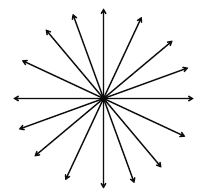
A line contains infinitely many points
An infinite number of lines can be drawn to pass through a given point
One and only one line can be drawn to pass through two given points A and B.

Collinear Points: Three or more points are said to be collinear, if there is a line which contains them all.

In the above figure; P, Q, R are collinear points.
Plane: A flat surface extended endlessly in all the four directions is called a plane. The surface of a smooth wall, the surface of the top of the table, the surface of a smooth blackboard, the surface of a sheet of paper etc. are close examples of a plane. These surfaces are limited in extent but the geometrical plane extends endlessly in all directions. Two lines lying in a plane either intersect exactly at one point or are parallel.
Intersecting Lines: Two lines having a common point are called intersecting lines. The point common to two given lines is called their point of intersection. In the figure, the lines AB and CD intersect at a point O.
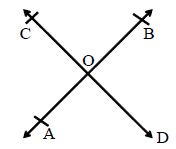
Concurrent Lines: Three or more lines in a plane are said to be concurrent, if all of them intersect at the same point. In the figure below, the lines l, m, n all intersect at the same point P; so they are concurrent.
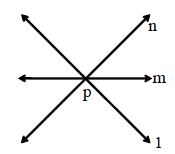
Parallel Lines: Two lines l and m in a plane are said to be parallel, if they have no point in common and is written as l || m. The distance between two parallel lines always remains the same.

Angle and its Angle Types,
Angles: Two rays OA and OB having a common end point O form angle AOB, written as ∠∠AOB.
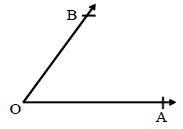
OA and OB are called the arms of the angle and O is called as its vertex.
Measure of an Angle: The amount of turning from OA to OB is called the measure of ∠∠AOB is written as ∠∠ AOB. An angle is measured in degrees, denoted by.

A complete rotation around a point makes an angle of 360°.
1° = 60 minutes, written as 60′.
1′ = 60 seconds, written as 60″.
We use a protractor to measure an angle.
Kinds of Angles
Right Angle: An angle whose measure is 90° is called a right angle.
Acute Angle: An angle, whose measure is more than 0° but less than 90°, is called an angle.
Obtuse Angle: An angle whose measure is more than 90° but less than 180° is called an obtuse angle.
Straight Angle: An angle whose measure is 180° is called a straight angle.
Reflex Angle: An angle whose measure is more than 180° but less than 360° is called a reflex angle.
Complete Angle: An angle whose measure is 360° is called a complete Angle.
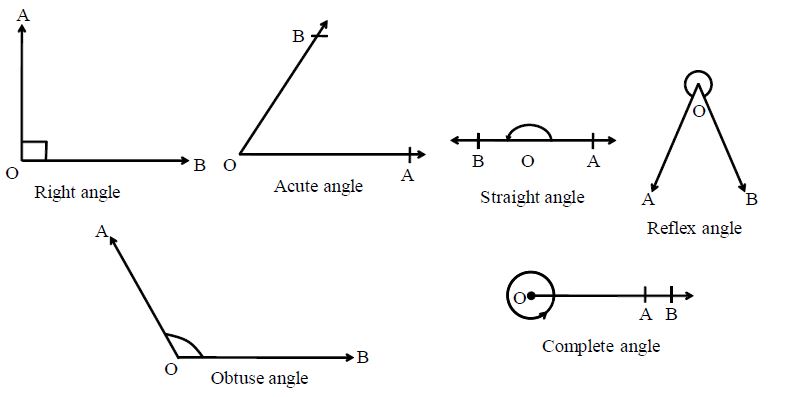
Equal Angles: Two angles are said to be equal, if they have the same measure.
Bisector of an Angle: A ray OC is called the bisector of ∠∠AOB, if m ∠∠AOC= m ∠∠BOC.
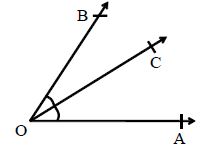
Complementary Angles: Two angles are said to be complementary, if the sum of their measures is 90°.
Two complementary angles are called the complement of each other.
Thus, Complement of an angle of 36° = An angle of (90° – 36°) = 54°.
Supplementary Angles: Two angles are said to be supplementary, if the sum of their measures is 180°. Two supplementary angles are called the supplement of each other.
Thus, supplement of an angle of 42° = An angle of (180° – 42°) = 138°.
Supplement of an angle of 115° = an angle of (180° – 115°) = 65°.
Adjacent Angles: Two angles are said to be adjacent angles, if they have a common vertex and a common arm such that the other arms of the two angles are on either side of their common arm.
In the adjoining figure, ∠∠AOB and ∠∠BOC are adjacent angles.
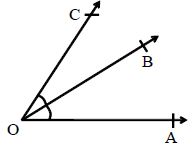
Linear Pair: If the sum of two adjacent angles is 180°, they are said to form a linear pair. In the adjoining figure, ∠∠AOB + ∠∠COB =.
So AOB and BOC together form a linear pair.
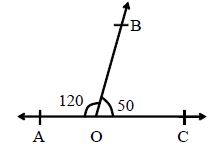
Important Results
Linear Pair Axiom: If a ray stands on a straight line, then the sum of the adjacent angles so formed is 180°. Thus, ∠∠AOC + ∠∠COB = 180° where AOB is a straight line.
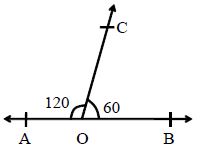
Converse of a Linear Pair Axiom: If two adjacent angles are supplementary, then the non-common arms of two angles are in a straight line. Thus if two adjacent angles ∠∠AOC and ∠∠BOC with common arm OB are such that ∠∠ AOC + ∠∠BOC = 180° then OA and OB are in the same straight line i.e. AOB is a straight line.
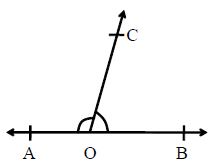
Angles at a Point: The sum of all the angles at a point is 360°.
In the given figure, we have ∠1 + ∠2 + ∠3 + ∠4 = 360°.
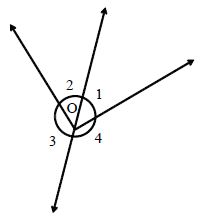
Vertically Opposite Angles: If two straight lines AB and CD intersect at a point O, then ∠AOC and ∠BOD form one pair of vertically opposite angles and the angles AOD and BOC form another pair of vertically opposite angles. When two lines intersect each other, then vertically opposite angles are always equal. In the given figure, we have: ∠AOC = ∠BOD and ∠BOC = ∠AOD.
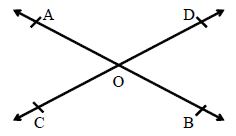
Parallel Lines: Two straight lines lying in the same plane are said to be parallel if they do not intersect no matter how long they are produced on either side. In the given figure, AB and CD are parallel lines and we write AB || CD.

Transversal: A straight line that intersects two or more lines is called a transversal. Let two lines AB and CD are cut by a transversal l, and then the following angles are formed.
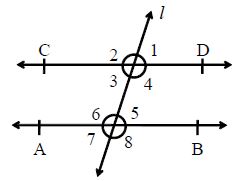
Pairs of Corresponding Angles (abbreviated as cores angel s): (angle 1, angle 5), (angle 2, angle 6), (angle 4, angle8), (angle 3, angle 7)
Pairs of Alternate Interior Angles (abbreviated as Alt. Int. angels): (angle 3, angle 5) and (angle 4, angle 6)
Pairs of Alternate Exterior Angles: (angle 2, angle 8) and (angle 1, angle 7)
Pairs of Consecutive Interior Angles (abbreviated as co. Int. s): (angle 4, angle 5) and (angle 3, angle 6)
Properties of Angles Associated with Parallel Lines
If two parallel straight lines are intersected by a transversal, then
Corresponding angles are equal. Angle 1 = angle 5, angle 2 = angle 6, angle 4 = angle 8 and angle 3 = angle 7
Alternate interior angles are equal. Angle 3 = angle 5 and angle 4 = angle 6
Alternate exterior angles are equal. Angle 2 = angle 8 and angle1 = angle 7
Co-interior angles (consecutive interiors) are supplementary. Angle 4 + angle 5 = 180° and angle 3 + angle 6 =180°.
Conditions of Parallelism: The converse of the above results is also true.
If two straight lines are intersected by transversal such that pair of corresponding angles is equal, then the two lines are parallel.
If two straight lines are intersected by a transversal such that pair of alternate angles is equal, then the two lines are parallel.
If two straight lines are intersected by a transversal such that a pair of consecutive interior angles is supplementary, then the two lines are parallel.
Basic Axiom of Parallel Lines: (Euclidian postulate)
There exists one and only one line which is parallel to a given line from a given point.
If two lines are parallel to the same line then the lines are parallel to each other.
TRIANGLE
A closed plane figure bounded by three line segments is called a Triangle. We denote a triangle by the symbol Δ∆. Δ∆ABC has:
Three vertices, namely A, B and C
Three sides, namely AB, BC and CA
Three angles, namely, ∠A, ∠B and ∠C.
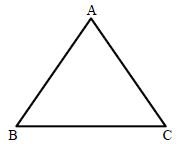
The three sides and the three angles are known as elements or parts of the Triangle.
Kinds of Triangles
Classification of Triangles according to Sides:
Scalene Triangle: A triangle, in which all sides are of different lengths, is called a scalene triangle.
In the following figure, ΔPQR∆PQR is a scalene triangle
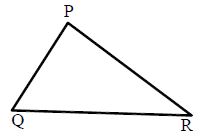
since PQ≠QR≠PRPQ≠QR≠PR
Isosceles Triangle: In an isosceles triangle, the angles opposite to the equal sides are equal. A triangle having two sides equal is called an isosceles triangle.
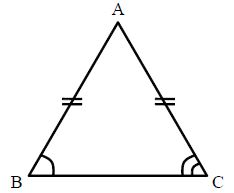
In ΔABC; AB=AC⇒∠B=∠CΔABC; AB=AC⇒∠B=∠C.
Equilateral Triangle: A triangle which is having equal sides is called an equilateral triangle. The measure of each angle of an equilateral triangle is 60°.
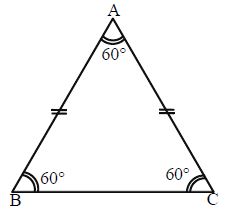
Classification of Triangles according to Angles:
Acute-Angled Triangle: A triangle, in which every angle measures more than 0° but less than 90°, is called an acute-angled triangle. In the below figure Δ∆PQR, we have: ∠P = 70°, Q = 45° and R = 65°.
Thus, each angle of PQR is acute.
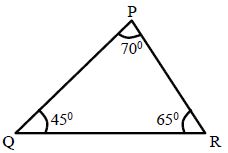
Right-Angled Triangle: A triangle in which one of the angles measures 90° is called a right angled triangle or simply a right triangle. In a right-angled triangle the side opposite to the right angle is called its hypotenuse and the remaining two sides are called its legs.
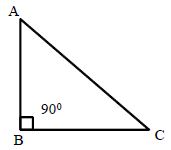
Δ∆ABC is a right triangle and ∠B = 90°, AC is the hypotenuse and AB and BC are its legs.
Obtuse-Angled Triangle: A triangle in which one of the angles measures more than 90° but less than 180° is called an obtuse- angled triangle.
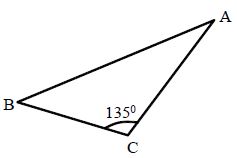
Here, Δ∆ABC is an obtuse-angled triangle in which ∠C =135°.
Median: A line segment joining a vertex to the mid-point of the opposite side of a triangle is called a median of the triangle. In the below figure, D is the mid-point of side BC of ABC. AD is a median of ABC. A triangle has 3 medians.
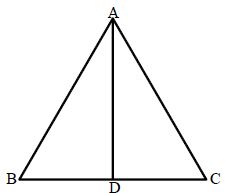
All the three medians of a triangle are concurrent i.e. they intersect at a point
Centroid: The point of intersection (concurrence) of the three medians of a triangle is called its centroid.
In the below figure, the three medians AD, BE and CF intersect at the point G.
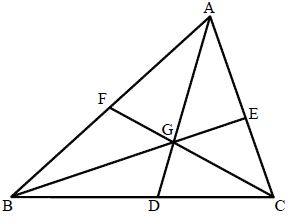
G is the centroid of Δ∆ABC
Altitude: The length of perpendicular from a vertex to the opposite side of a triangle is called its altitude and the side on which the perpendicular is being drawn, is called its base. In the below figure, AL⊥⊥BC.
So BC is the base and AL is the corresponding altitude of the triangle. A triangle has three altitudes. All the three altitudes of a triangle are concurrent i.e., they intersect at a point.
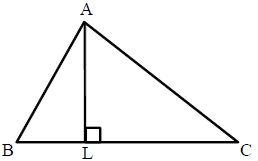
Orthocentre: The point of intersection (concurrence) of the three altitudes of a triangle is called its orthocentre. In the figure below, the three altitudes AL, BM and CN of Δ∆ABC intersect at a point H.
Therefore, H is the orthocentre of ABC.
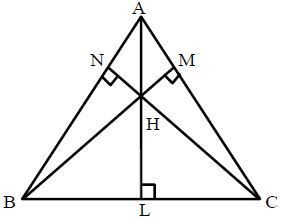
In centre and in circle: The point of intersection of the internal bisectors of the angles of a triangle is called its in centre in the below figure, the bisectors of the internal angles of a Δ∆ABC meet at a point I. So, ‘I’ is the in centre of ABC. The in centre of a triangle is the center of a circle which touches all the sides of the triangle and this circle is called the in circle of the triangle. If ID⊥⊥BC, then ID is called the radius of the in circle.
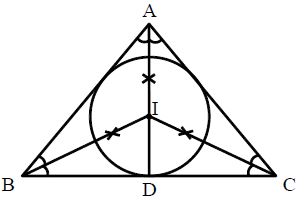
Circumcentre and Circumcircle: The point of intersection of the perpendicular bisectors of the sides of a triangle is called its circumcentre. In the below figure, the perpendicular bisectors of the sides AB, BC and CA of Δ∆ABC intersect at a point O. So O is the Circumcentre of the triangle. The circumcentre of a triangle is the centre of a circle which passes through the vertices of the triangle and this circle is called the circumcircle of the triangle. Clearly, OA = OB = OC = radius of circumcircle.
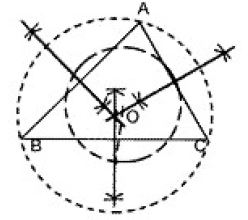
Exterior and Interior Opposite Angles of a Triangle: Take a triangle ABC whose one side BC will make to D; then an exterior angle is triangle ACD. and its interior opposite angles is the angles A and B .
Properties of Triangles
Angle Sum Property: The angles of a triangle have the sum of 180°.
When the two sides of a triangle are equal in length, then the opposite angles to them are of equal measures.
In a triangle, the sum of angles of any two sides is always greater than the angles of third side.
Whenever the 2 sides of a triangle are of not equal length, then the greater side of the triangle has the greater angle of triangle opposite to it.
If any one side of a triangle is making the exterior angle then it is equal to sum of all other interior opposite angles.
In a triangle the outer angle is always, greater than its inner opposite angle. The sum of (outer) exterior angles of a triangle is always 360°.
2. Quadrilaterals, Polygons and Three Dimensional Shapes
- Books Name
- CBSE Class 6 Mathematics Book
- Publication
- Param Publication
- Course
- CBSE Class 6
- Subject
- Mathmatics
Line Segment
A line segment is a fixed portion of a line. This makes it possible to measure a line segment. This measure of each line segment is a unique number called its “length”. We use this idea to compare line segments.
To compare any two line segments, we find a relation between their lengths.
This can be done in several ways.
(i) Comparison by observation: The method of comparing two segements by observations is not always correct. Therefore, we need a better method.
(ii) Comparison using Ruler and a Divider :
(a) Using a Ruler : Suppose we have to measure the length of a given segment AB. Take a ruler with centimeter marks and place it along the segment AB such that the

zero mark on the ruler is just at A as shown in the figure. Now read the mark on the ruler which corresponds to B. In this figure we see that the mark corresponding to B is the eighth small division after 5, i.e. AB contains 5 full centimeters and 8 millimeters. We say that the length of AB is 5.8 cm and write it as AB = 5.8 cm.
(b) Using a Divider : We open the divider such that the point of one arm is at A and the second exactly at B, i.e. the segment AB is contained in the divider. Now lift the divider carefully without disturbing its opening and place it on the ruler so that one point of the divider is at zero (0) mark. We then read the mark which corresponds to the second point of the divider.
In the adjoining figure the second point of the divider is at the seventh mark after 3,
i.e. AB contains 3 complete centimetres and seven-tenths of a centimetre. We say that AB is 3 cm and 7 mm and write it as AB = 3.7 cm.
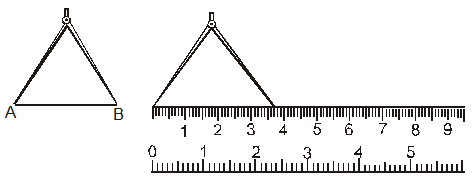
Units for measurment of line segments :The unit of measurment of length is metre.
A metre is divided into 100 equal parts, each called a centimetre. A centimetre is further subdivided into 10 equal parts, each called a millimetre.
Thus we have the following table :
10 Millimetres (mm) = 1 Centimetre (cm)
10 Centimetres(cm) = 1 Decimetre (dm)
10 Decimetres (dm) = 1 Metre (m)
or , 1 metre = 10 decimetres
= 100 centimetres
= 1000 millimetres
Ex. If B is the mid point of AC and C is the mid-point of BD where A, B, C and D are collinear, show that AB = CD ?
Sol. B is the mid-point of AC
∴ AB = BC .....(i)
Again C is the mid-point of BD
CD = BC .....(ii)
From (i) and (ii), we get
AB = CD
![]()
2. Quadrilaterals, Polygons and Three Dimensional Shapes
- Books Name
- Class 6 Mathematics Book
- Publication
- ReginaTagebücher
- Course
- CBSE Class 6
- Subject
- Mathmatics
Quadrilaterals, Polygons and Three Dimensional Shapes
QUADRILATERALS
A closed figure surrounded by four line segments is called a quadrilateral.
A quadrilateral ABCD has:
Four vertices, named as A, B, C and D
Four sides, named as AB, BC, CD and DA
Four angles, named as angle A, angle B, angle C and angle D
Two diagonals, named as angle AC and angle BD
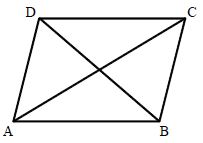
Adjacent Sides
Two sides of a quadrilateral triangle are having a common close (end) point are known as triangle’s adjacent or consecutive sides. In the quadrilateral given below, There are four pairs of its adjacent sides. (AB, BC), (BC, CD), (CD, DA) and Opposite Sides are (BA, AD)
opposite sides of the triangle are defined as the Two sides of the quadrilateral are having no common end point.
In the quadrilateral (AB, CD) and (BC, AD) are opposite sides of its two pairs.
Adjacent Angles
Two angles of a quadrilateral that are having a common section are called its adjacent or consecutive angles. In the quadrilateral (angle A, angle B), (angle B, angle C), (angle C, angle D) and (angle D, angle A) are four pairs of adjacent angles of triangle
Opposite Angles
Two angles of a quadrilateral triangle are not having a common section are called its opposite angles of triangle.
In the quadrilateral (angle A, angle C) and (angle B, angle D) are two pairs of its opposite angles of triangle.
The sum of all the angles of a quadrilateral triangle is 360°.
The sum of exterior angles of a quadrilateral triangle is 360°.
Parallelogram
A quadrilateral triangle in which two pairs of opposite sides are parallel is called a parallelogram.
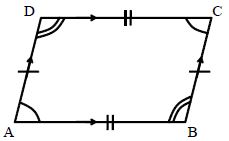
In a Parallelogram:
Opposite sides are equal
Opposite angles are equal
each diagonal bisects the parallelogram
when pair of opposite sides of a Quadrilateral triangle are equal and parallel, it is a parallelogram
Rectangle: A parallelogram each of their angle having size of 90° is called a Rectangle.
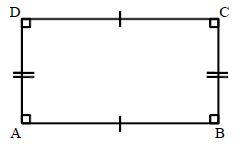
In a Rectangle:
Opposite sides are equal
each angle measure is 90°
Diagonals are equal
Diagonals bisect each other
Square: A Rectangle that has all sides equal is known as a square. When two adjoining sides of a Rectangle are equal, then it is known as a Square
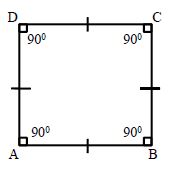
In a Square:
All sides are equal
Each angle measures 90°
Diagonals are equal
Diagonals bisect each other
Diagonals intersect at right angles
Rhombus: A parallelogram that have all sides equal is known as a Rhombus
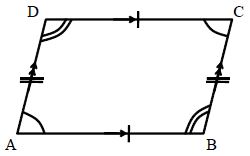
In a Rhombus:
Opposite sides are parallel
All sides are equal
All Diagonals cut across each other at right angles of triangle
Trapezium: A Quadrilateral in which two opposite facing sides are parallel is known as a trapezium. In diagonal divides proportionally
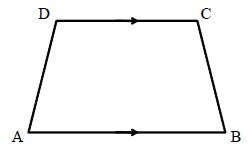
when the (unequal) non parallel sides of a trapezium are equal. It is called as isosceles-trapezium
Kite: The Quadrilateral in which two pairs of the adjacent sides are equal is called as a kite. The longer diagonal intersects the shorter diagonal.
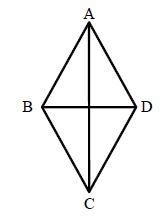
Relation between Quadrilaterals
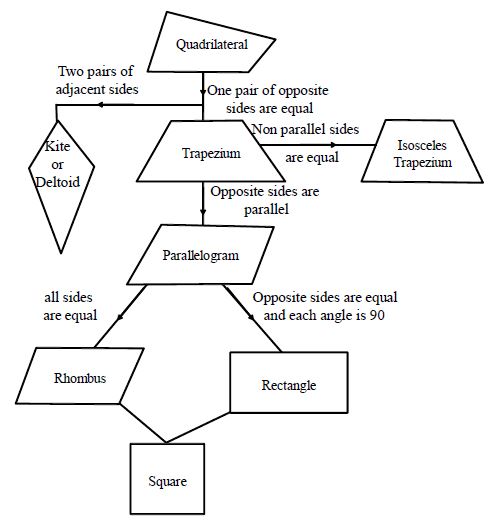
POLYGONS
A closed plane image enclosed by three or more line segments is known as a polygon. The line sections that form a polygon are called its sides. The point of intersection of two following sides of a polygon is known as a vertex.
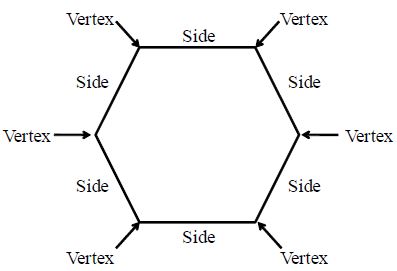
The total number of vertices of a polygon is always equal to the number of its sides.
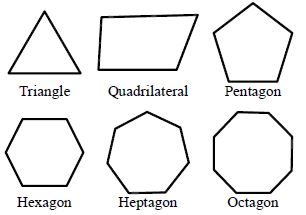
A polygon of n-sides is called n-gon. Thus, a polygon of 20 sides is a 20-gon
Diagonal of a Polygon
A line segment that join with any two non-consecutive vertices of a polygon is called diagonal of polygon. Therefore, in the figure ABCDE is a polygon image and each of the line segments AC, AD, BD, BE and CE is the diagonal of the polygon.
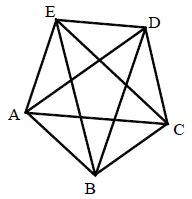
Interior and Exterior Angle of a Polygon:
An angle made by the two consecutive (following) sides of the polygon is known as an interior angle or we can say that an angle of the polygon.
|
Name of Polygon |
Number of sides |
Number of Triangles formed |
Angle sum of polygon |
|
Triangle |
3 |
1 |
1×180°=180°1×180°=180° |
|
Quadrilateral |
4 |
2 |
2×180°=360°2×180°=360° |
|
Pentagon |
5 |
3 |
3×180°=540°3×180°=540° |
|
Hexagon |
6 |
4 |
4×180°=720°4×180°=720° |
|
Heptagon |
7 |
5 |
5×180°=900°5×180°=900° |
|
Octagon |
8 |
6 |
6×180°=1080°6×180°=1080° |
|
Nonagon |
9 |
7 |
7×180°=1260°7×180°=1260° |
|
Decagon |
10 |
8 |
8×180°=1440°8×180°=1440° |
|
Undecagon |
11 |
9 |
9×180°=1620°9×180°=1620° |
|
Dodecagon |
12 |
10 |
10×180°=1800°10×180°=1800 |
From this s table, we can see that the number of triangles formed in a polygon is two smaller than the number of sides. So for a polygon with n sides, the number of triangles formed is n – 2.
A polygon with n sides has the angle sum :( n – 2) × 180°.
Hence, S = (n – 2) 180°.
In a regular polygon with n sides each inside angle is equal to (n–2) ×180n (n–2) ×180n
When each side of a polygon is produced (extended) in a clockwise or anti clockwise direction, surface (outer part of the angel) angles are formed as shown.
The sum of the exterior angles of any polygon is 360°.
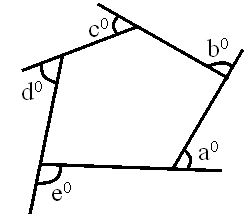
THREE DIMENSIONAL Figures
Solid State Figures: Figures with height/density (thickness), length, breadth and are called solids.
Cuboids: The solid in rectangular shape having the four slanting sides with top and base are called ‘cuboids’. The solid formed by six rectangular surfaces is called cuboids
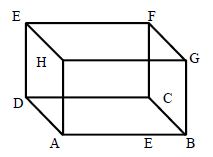
E.g.: Bricks, Eraser.
Number of surfaces = 6
Number of vertices = 8
Number of edges = 12
Cube: A Solid formed by the enclosure of six square plane surfaces is called a ‘cube’. Cube has – six faces, eight vertices, twelve edges.
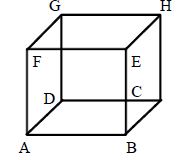
Cylinder: The figures which have top and base are circular in shape. The remaining surface is called curved surface.
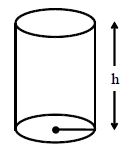
Cone: The base is a circle. Its radius is denoted by r. ACAC is called slant height and it is denoted by‘s’. AOAO is called vertical height and it is denoted by ‘h’. A is called its vertex.
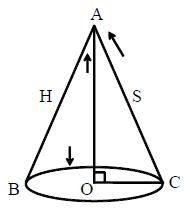
Sphere: Ball, Marbles and balls in the cycle bearings are some of examples of Sphere. In the below figure, ‘centre’ is called as O. AOAO is called its radius. Its surface is called curved surface.
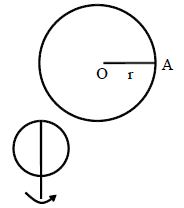
Prism: Triangular Prism. The adjoining figure shows a ‘triangular prism’. (Its base is a triangle) It is the shape of its base. It has six vertices and five surfaces.
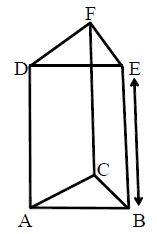
Pyramid: Pyramid figures base is in square shape and their lateral faces are in triangular shape, such that all the four surfaces meet at one point.
The below figure tells about square ABCD as its base in the pyramid shape.
AB =BC=CD=DA = aAB¯=BC¯=CD¯=DA¯=a, shows the side of its base.
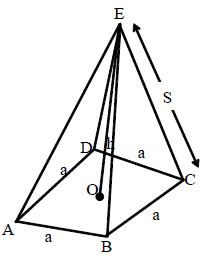
EOEO = h is called its vertical height. ECEC = s is called its slant height or lateral height. There are five surfaces with the square base and four triangular shaped surfaces all together.
Triangular Pyramid: If a pyramid has triangular base, then it is called a ‘triangular pyramid’. It has one triangular base and three triangular lateral surfaces. All together the triangular pyramid has four triangular faces.
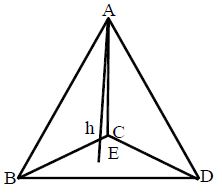
The adjoining figure shows a ‘triangular pyramid’. Its base is a triangle BCD. Lateral height of each triangle (lateral surfaces) is called the slant height which is denoted as s and the point of meeting all the lateral sides. ‘Apex or vertex’ is denoted by ‘A’.
AEAE = h is called height.
Degree Measure & Magnitude of an Angle
- Books Name
- CBSE Class 6 Mathematics Book
- Publication
- Param Publication
- Course
- CBSE Class 6
- Subject
- Mathmatics
Degree measure of an Angle
Circles divides into 360 equal parts and the unit is one of the 360 parts, or ![]() This unit is called degree, we usually use the sign(°).
This unit is called degree, we usually use the sign(°).
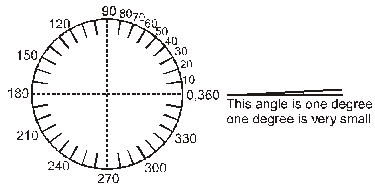
The drawing above shows a circle divided into 360 equal parts. The numerals label the marks
for each of 10 arcs, beginning at 0. The arc from 0 to 1 is a 1-degree arc. 1° is read “one degree”. The arc from 0 to 10 is a 10-degree arc.

The following illustrates the number of degrees in angles of standard rotations.
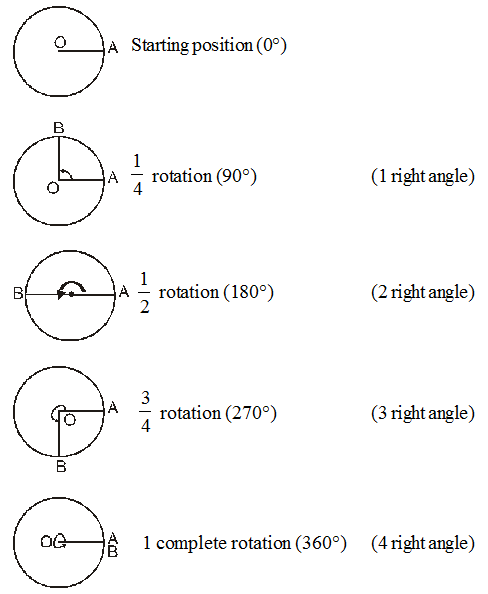
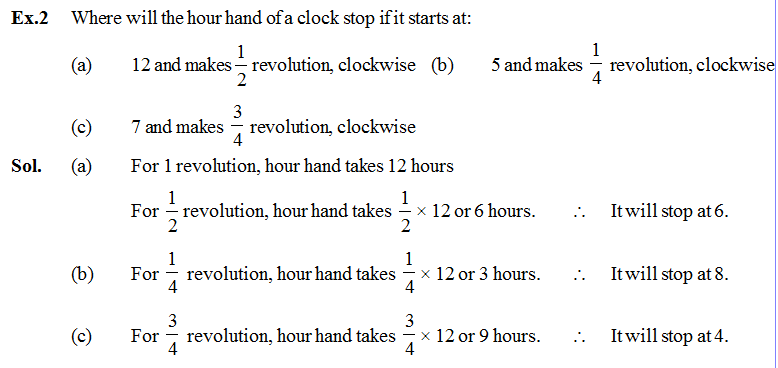
Magnitude of An angle
Magnitude of an angle is the amount of rotation through which one of the arms must be rotated about the vertex to bring it to the position of the other arm.
Kinds of Angle
- Books Name
- CBSE Class 6 Mathematics Book
- Publication
- Param Publication
- Course
- CBSE Class 6
- Subject
- Mathmatics
Kinds of angle
Angles are classified according to their degree measure.
(i) Acute Angle : An angle smaller than a right angle is called an acute angle.
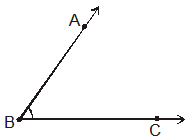
(ii) Right Angle : An angle which measures 90º is called a right angle. In Fig. ABC is a right angle.
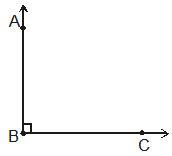
(iii) Obtuse Angle : If an angle is larger than a right angle, but less than a straight angle, it is called an obtuse angle.
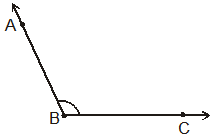
(iv) Straight Angle : An angle which measures 180° is called a straight angle in figure. ∠ABC is a straight angle.
![]()
(v) Reflex Angle : An angle which measures greater than 180° and less than 360° is called a reflex angle. ∠AOC is a reflex angle.
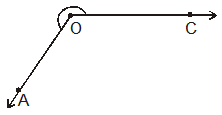
(vi) Complete Angle : An angle which measures 360° is called a complete angle. ∠AOB is complete angle.

Perpendicular lines
When two lines intersect and the angle between them is a right angle, then the lines are said to be perpendicular. If a line AB is perpendicular to CD, we write AB ⊥CD.
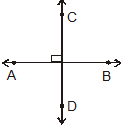
Perpendicular bisector
A line perpendicular to the given line segment as well as bisects it, is called perpendicular bisector. Line LM is perpendicular bisector of line segment AB.
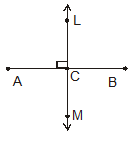
Classification of Triangles
- Books Name
- CBSE Class 6 Mathematics Book
- Publication
- Param Publication
- Course
- CBSE Class 6
- Subject
- Mathmatics
Classification of Triangles
A polygon of 3 sides. It has 3 angles and 3 sides. So we classify triangles according to sides as well as according to angles.
(i) According to sides, the triangles are
(a) Scalene Triangle : If all the sides of a triangle are unequal in length, it is called a scalene triangle. ∆ABC is a scalene triangle.
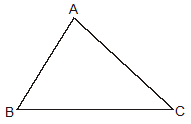
(b) Isosceles Triangle : If two sides of a triangle are equal. it is called isosceles triangle.
In ∆ABC sides AB and AC are equal.
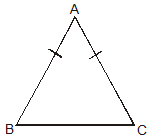
(c) Equilateral Triangle : If all the three sides of a triangle are equal, it is called equilateral triangle. AB = AC = BC, so ∆ABC is an equilateral triangle.
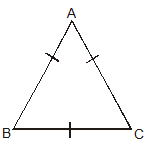
(ii) According to angles, the triangles are
(a) Acute angled Triangle : A triangle whose all angles are acute is known as an acute angled triangle.
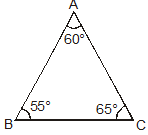
(b) Right angled Triangle : A triangle whose one of the angles is a right angle is called a right angled triangle.
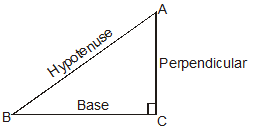
The side opposite to the right angle is called the hypotenuse and the other two sides are called the legs of the triangle. One leg (side) is perpendicular and other one is base.
(c) Obtuse angled Triangle : A triangle whose one of the angles is obtuse angle is called an obtuse angled triangle.
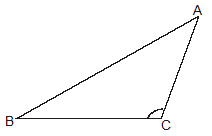
Relation between Sides and Angles of a Triangle :
(a) The angles of a scalene triangle are unequal.
(b) In an isosceles triangle, two angles are equal.
(c) All the angles of an equilateral triangle are equal. Each angle is 60°.
(d) If two angles of a triangle are equal then the sides opposite to them are also equal.
(e) A right angled triangle with two sides equal is called an isosceles right angled triangle.
Quadrilateral
- Books Name
- CBSE Class 6 Mathematics Book
- Publication
- Param Publication
- Course
- CBSE Class 6
- Subject
- Mathmatics
Quadrilateral
A quadrilateral is a polygon of 4 sides. In other words, a quadrilateral is a closed plane figure with four sides.
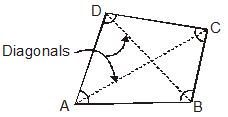
The line segments AC and BD are its diagonals.
The classification of quadrilaterals is summarised below :
1. Parallelogram
A parallelogram is a quadrilateral in which both pairs of opposite sides are parallel.
In the given figure, side AB is parallel to DC and side BC is parallel to AD or also we can write as AB || DC, AD || BC, therefore ABCD is a parallelogram.
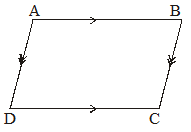
2. Rectangle
A rectangle is a parallelogram, whose all angle is a right angle.
In the given figure, ABCD is a rectangle.
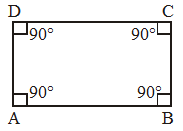
3. Rhombus
A rhombus is a parallelogram whose all sides are equal.
In the figure, PQRS is a parallelogram in which PQ = QR = RS = SP.
Diagonals PR and QS bisect each other at 90°.
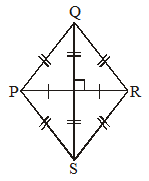
4. Square
A square is a parallelogram whose all sides are equal and each angle are right angle.
In the given figure, AB = BC = CD = DA and ∠A = ∠B =∠C =∠D = 90°.
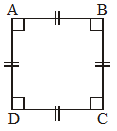
5. Trapezium
A trapezium is a quadrilateral with only one pair of opposite sides parallel.
In the given figure, ABCD is a trapezium in which AB || DC.
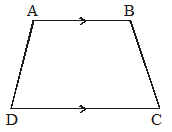
Polygon
- Books Name
- CBSE Class 6 Mathematics Book
- Publication
- Param Publication
- Course
- CBSE Class 6
- Subject
- Mathmatics
Polygon
A polygon is a plane closed figure made up of lines segments. The minimum number of sides of a polygon is three. A polygon can have more than 3 sides.
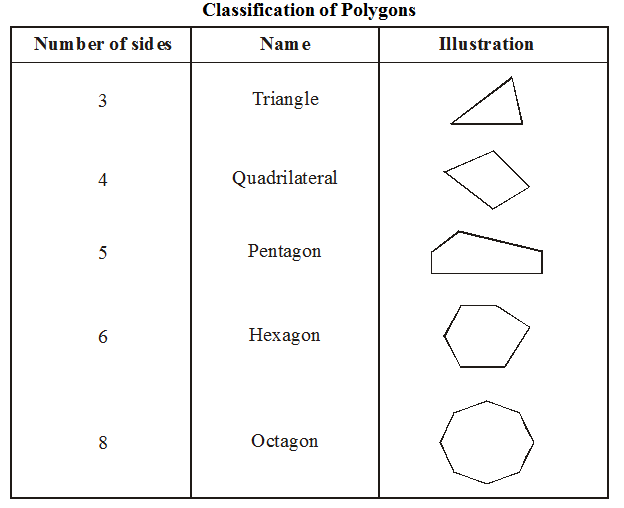
Regular polygon :
A polygon is called regular if all its sides are equal in length and all angles are equal in measure.
Solid Figures
- Books Name
- CBSE Class 6 Mathematics Book
- Publication
- Param Publication
- Course
- CBSE Class 6
- Subject
- Mathmatics
Solid Figures
A Closed figure which lies in more than one plane is called a solid figure.
The figures such as cube, cuboid, cylinder, pyramid, etc., which have three dimensions, namely length, breadth and height are called solid figures or 3-dimensional figures.

Solid figures (Three dimensional figures)
Faces, Edges and vertices of Solid Figure
• The surface of a solid is called its Face.
• An Edge is a line segment that is the intersection of two faces.
• A corner or Vertex in a solid shape is the point where the faces meet.

Types of Solids
- Books Name
- CBSE Class 6 Mathematics Book
- Publication
- Param Publication
- Course
- CBSE Class 6
- Subject
- Mathmatics
Types of solids
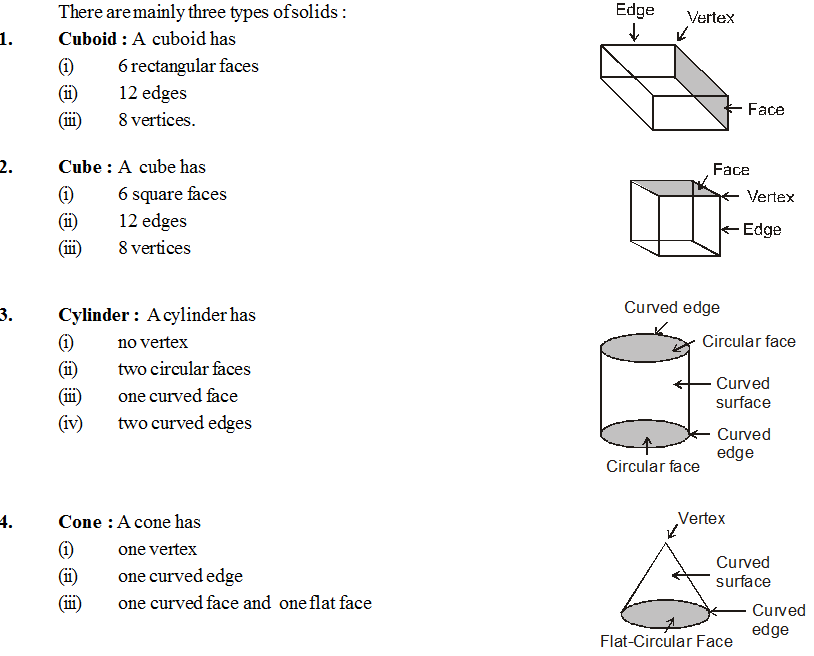
5. Prism : A solid whose base and top are identical polygons and side faces are rectangles, is called a prism. In a square prism whose base and top are congruent squares. Cuboid, cube etc.
are all special types of prisms.

6. Pyramid : A solid whose base is any polygon and side faces are triangles, is called a pyramid. Figure shows a pentagonal pyramid.

7. Triangular Pyramid : A triangular pyramid (Tetrahedron) shown in fig. has :
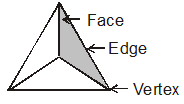
(i) 4 faces
(ii) 6 edges
(iii) 4 vertices
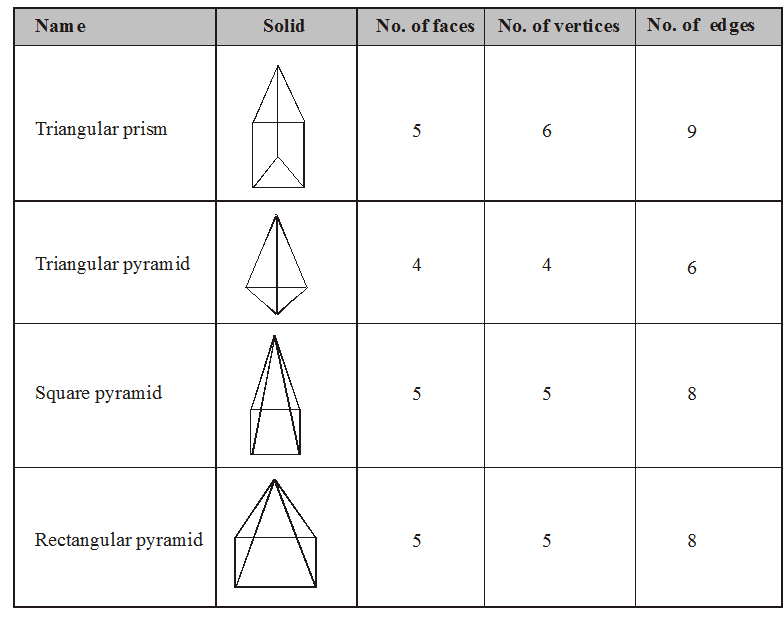

 Param Publication
Param Publication
 ReginaTagebücher
ReginaTagebücher
